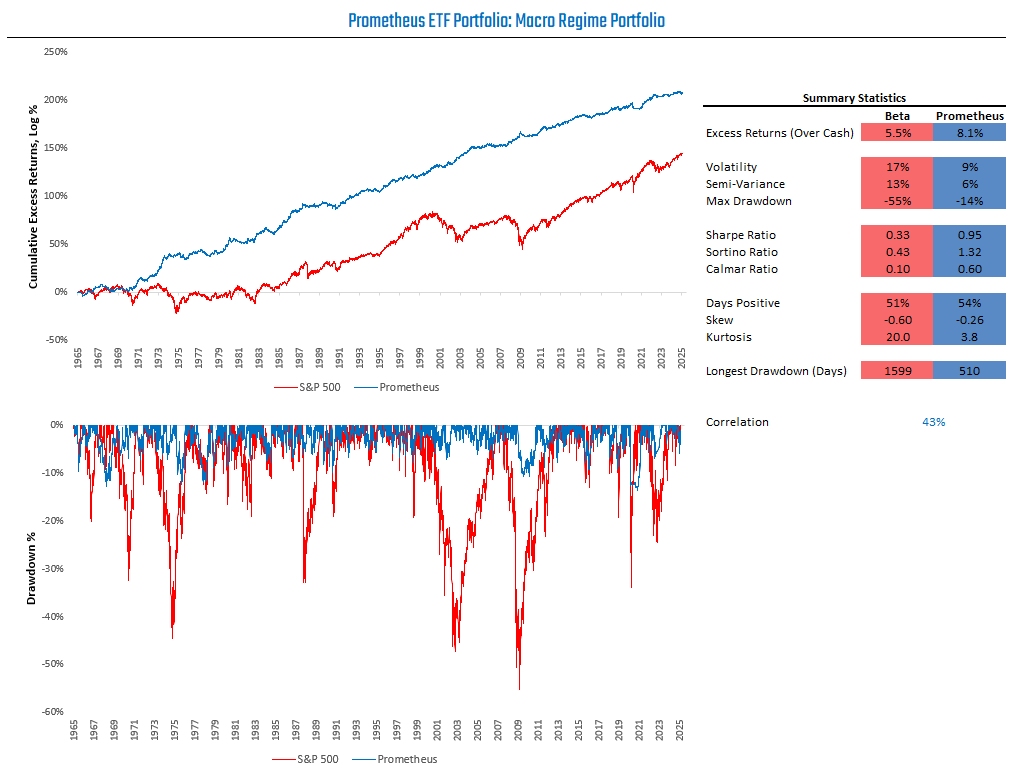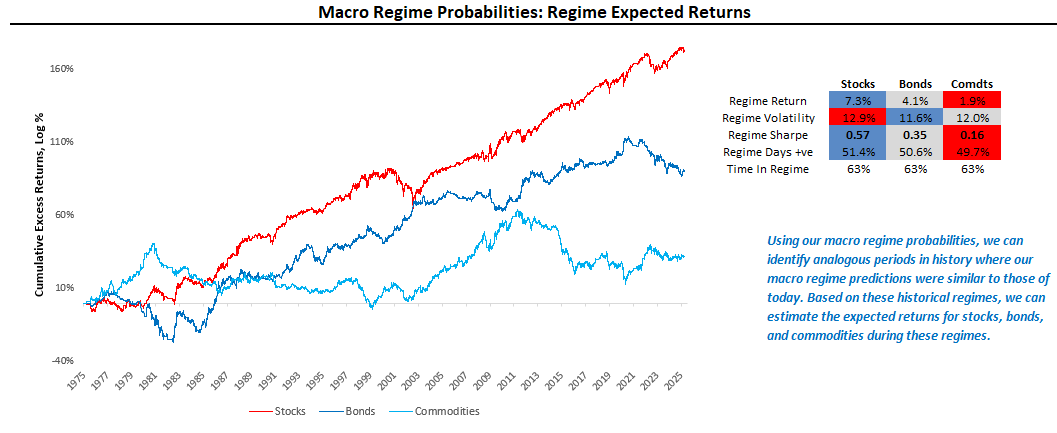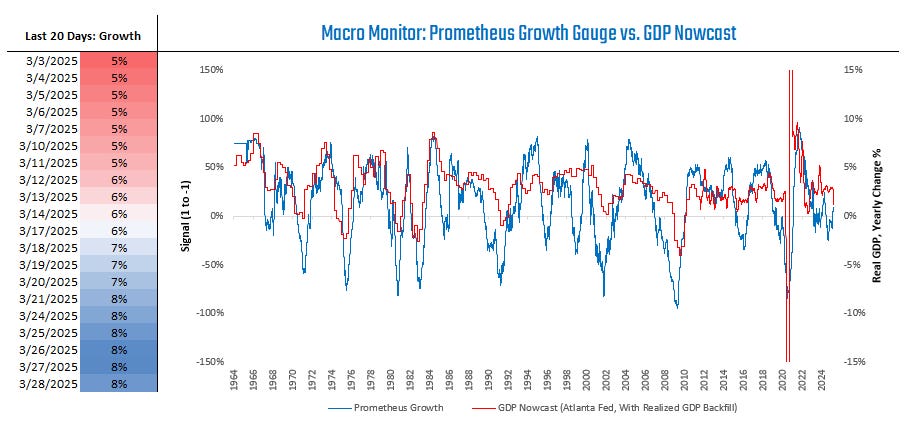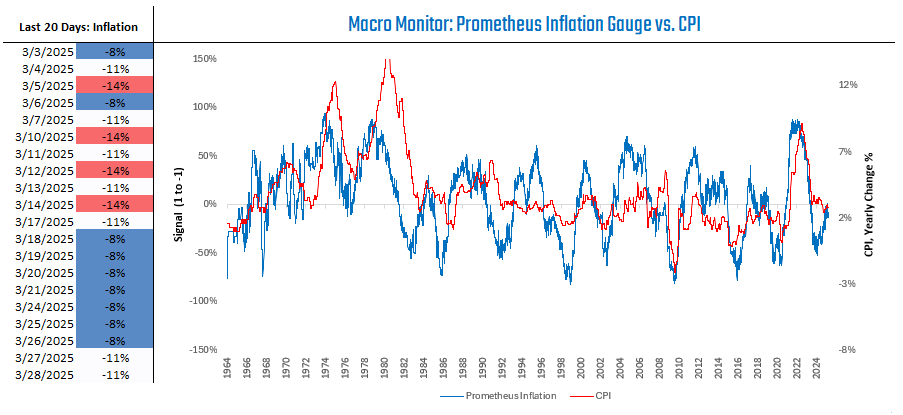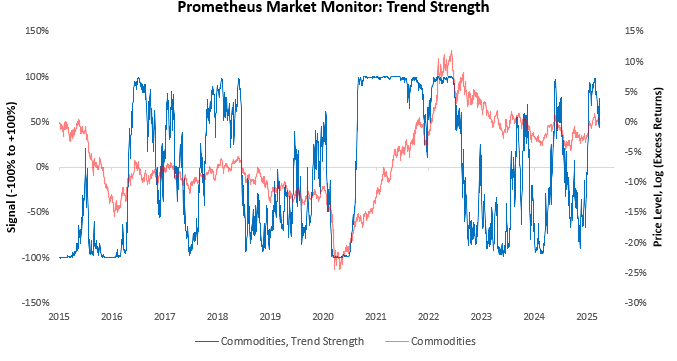Welcome to Prometheus ETF Portfolio. The Prometheus ETF Portfolio aims to allow everyday investors to access an investment solution that combines active macro alpha, passive beta, and strict risk control, all in an easy-to-follow, low-turnover solution. We aim to achieve strong risk-adjusted returns relative to cash, with limited capital drawdowns in depth and duration. We do this in a highly accessible package, which rotates between three highly liquid ETFs, readily available to any investor with a brokerage account.
Our observations are as follows:
The distribution of macroeconomic regime probabilities remains relatively flat. Given this backdrop, outsized bets on any market are not warranted.
Our high-frequency tracking of macroeconomic fundamentals shows no meaningful change to overall economic activity, with growth expanding, inflation slowing, and earnings rising.
Macro market trends remain consistent with inflationary outcomes.
Our systems take signals from markets and the economy to create a comprehensive, high-frequency view. Given the current backdrop, diversification, with modest tilts and tight risk control, is likely to outperform. Our current allocations reflect this.
Let's begin sharing the data driving our current assessment of the macro regime and our ensuing risk management and positions.
Macro Regime Monitor
Our Macro Regime Monitors combine measures of macro trend, mean reversion, expected returns, and fundamental economic conditions to estimate tomorrow’s cross-asset, macro market environment. We recommend checking out the primer if you’re unfamiliar with these tools:
We share the latest readings below:
Our Macro Regime Monitors continue to show a flat distribution of probable future macroeconomic regimes. We visualize the expected return profiles one can expect during this distribution of predicted regimes below:
As we see above, all assets have positive expected returns within the current distribution of expected regimes.
Fundamental Macro Monitor
Our Macro Regime Probabilites account for changes in market prices and fundamentals. Our systems aggregate an extremely wide variety of fundamental economic data to create timely leading estimates for the direction of growth and inflation. We zoom into these fundamental gauges to offer a more granular view of the factors driving our strategies.
We begin with our Growth Gauge. Our Growth Gauge aggregates data across hundreds of economic growth variables to create a timely read of forward-looking macro pressures on GDP growth. We visualize this gauge below:
As we can see above, the latest readings for our growth gauge have modestly inflected upwards, which remains inconsistent with a recessionary circumstance. This is inconsistent with recent trends in the equity market but consistent with those in the commodity market.
Next, we turn to our Inflation Gauge. Our Inflation Gauge, much like our Growth Gauge, aggregates data across hundreds of economic growth variables to create a timely read of forward-looking macro pressures on future inflation. We visualize this below:
Our Inflation Gauge has shown increased downward pressures on future CPI, coming from weakening housing data.
Given the uncertainty around the economic environment, we also share the latest readings from our Earnings Expectations Monitor, which aggregates data from financial conditions and fundamental earnings drivers to estimate the likely path for S&P 500 earnings expectations:
As we can see, our gauges have offered a timely and leading insight into cyclical changes in earnings expectations. Today, S&P 500 earnings expectations are minimally above our estimates.
Thus, our fundamental readings suggest a rising growth and falling inflation environment with expanding earnings.
Market Monitor
Our Macro Regime Probabilites account for changes in market prices and fundamentals. We now zoom in on some of the market measures we track. Particularly, we focus on measures of trend, as they help us contextualize the current backdrop and signal the need for risk management.
We begin with stocks:
Equity markets remain in a downtrend but with considerable noise.
We turn to bonds next.
Bond markets have rallied in response to the equity sell-off but remain within a downtrend. We turn to commodities.
Commodity markets continue to experience the strongest trends on a cross-asset basis. Overall, market trends are signaling an inflationary bias.


